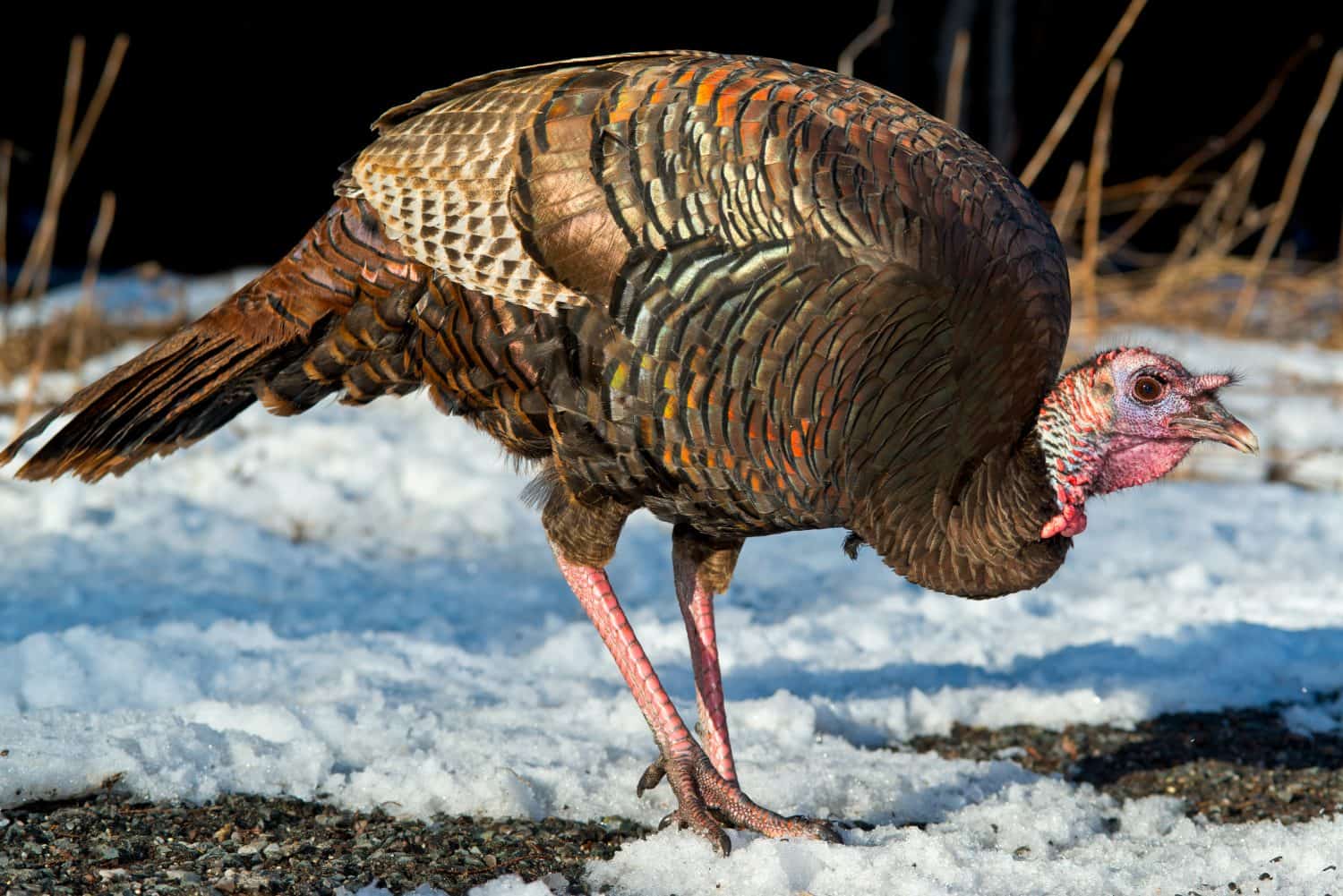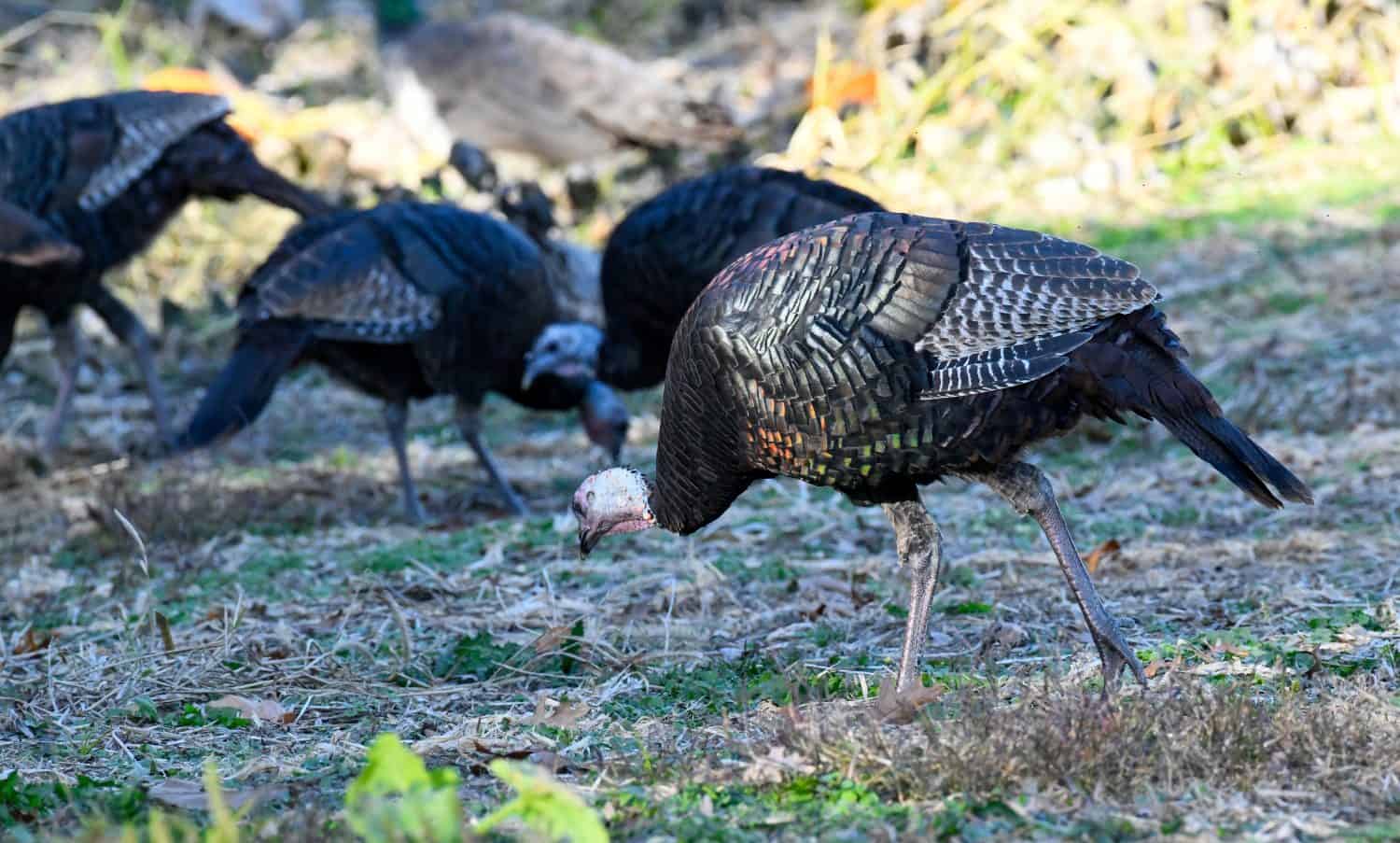Wild turkeys can be mysterious. They suddenly appear in a clearing, sometimes by the dozen, and disappear just as fast. Turkeys are very well camouflaged, so once they disappear into the woods, it is very hard to find them. The hens are not as vibrantly colored as the toms in order to blend in with the undergrowth while sitting in their nest. The toms are more frequently seen as they meander about, gobbling and looking a bit bored once their flock of ladies signs off for the day to return to their secluded nests. Wild turkeys continue to be a bit of a mystery in winter when it should be easier to see them, though it isn’t. What do wild turkeys even eat in the winter when there is so little to be found, especially if they are in a snow-covered area?
Meet the Wild Turkey

Wild turkeys can see better than humans, which comes in handy when looking for food on the ground.
©iStock.com/Robert Winkler
Wild turkeys are large-bodied birds that can be found throughout most of North America. The turkeys we have in the U.S. are related to those who are native to Mexico. There are several species of wild turkeys in the U.S., including the eastern wild turkey, Osceola wild turkey, Gould’s wild turkey, Merriam’s wild turkey, Rio Grande wild turkey, and the ocellated wild turkey.
Turkeys typically weigh 5 – 24 pounds and live for approximately three to five years. They have large bodies, long, thin necks, long legs, and tiny heads. The males’ plumage is more vibrantly colored than the females, as already mentioned. The feathers on their backs have an iridescent rainbow sheen over the dark brownish-black coloring. The front feathers are brownish-black with white stripes. The tail feathers are long and light to dark brown with a light beige tip. The males’ heads can be blue, red, pink, or white, depending upon their mood. A bit like a mood head instead of a mood ring!
The females are considerably smaller, with somewhat muted feather coloring and pretty brown eyes framed with black lashes. They have been hunted to near extinction in many places, and their numbers have risen with help from turkeys brought in from other areas of the U.S.
Foods Wild Turkeys Eat During Winter

Female turkeys typically stay with a flock of other females and one tom.
©Paul Reeves Photography/Shutterstock.com
1. Berries
An important part of the wild turkey’s diet in the cold winter months is berries. Even in the frigid temperatures, berries can be found on some bushes and trees like holly. The turkeys will fly or use their strong legs to launch themselves to a low branch where they can collect the tasty berries and also remain out of danger’s way. After all, turkeys are pretty low on the food chain, and predators have a difficult time in winter, just like all the other animals.
2. Tree & Flower Buds
While we’re discussing turkeys in trees, the birds also enjoy consuming new growth on trees and any buds from flowers. Turkeys aren’t too picky when it comes to what’s on their dining menu and will eat just about anything they can fit in their mouths. New tree growth offers fiber and moisture, which might be hard to come by in the winter. Once they are up in a tree eating berries, they stick around to eat anything else that makes any sense. These sweet birds have been seen throwing down buds, berries, and insects to their other flock members.
3. Nuts
Also, while in the trees, they might come across an acorn, beech nut, or hickory nut. These are all important parts of the turkey’s diet in winter. They contain fat and calories, both of which help the turkeys maintain weight in the colder months. Another bonus to eating nuts is they sometimes contain insects, which the turkeys also eat. Nuts can also be found on the ground that the turkeys scratch up even when there is a bit of snow.
4. Hemlock and Pine Needles
Though it may not sound appetizing to us, pine and hemlock needles contain vitamins A and C, which are very beneficial in the winter months. The birds make a meal of low-lying branches when little else can be found to eat, or maybe they like the needles.
5. Lichen and Mosses
Along with everything else about a tree, the lichen and moss growing on or around them are apparently appetizing to a hungry turkey. They both have fiber and loads of protein and are packed full of carbohydrates to give the turkeys energy to jump into those trees and wander around rather aimlessly.
6. Grasses
While on the ground, turkeys will eat grass and dig it up when it is under the cover of snow. It offers moisture, protein, and fiber. Since grass grows in many areas, it is easy to come by and requires little energy from the turkeys.
7. Leftover Grain
Turkeys love to check out grain fields after the plow has come through. Wheat, soybeans, corn, and other grains tend to get left behind. They offer a bit of nutrition for the hungry birds, but they will be sharing with an abundance of other types of animals.
8. Insects
Winter isn’t the best time to scour the earth for insects; the turkeys still manage to find them. The turkey’s powerful legs help enable them to scratch fairly deep into the soil and can overturn rocks, which can have plenty of insects underneath. On warmer winter days, insects and arachnids that slow down during the colder months may thaw out and become active, making them easy targets.
Foods Wild Turkeys Eat During Other Seasons

Turkeys are not picky eaters and will eat anything they can fit into their mouths.
©Nancy Hixson/Shutterstock.com
In the other seasons, finding food is much easier, and the selection is much broader than it is in winter. They have many more insects to choose from; grains are growing, about to be harvested, or have just been harvested, which makes them fair and easy game for the turkeys. Berries are also much more likely to be abundant and offer a much wider selection. Turkeys also eat frogs, mice, salamanders, and some lizards, all of which are active in the warmer months. It’s not easy being a turkey, but they sure do have a wide variety of foods in their diet!
The photo featured at the top of this post is © davidsdodd/iStock via Getty Images
Thank you for reading! Have some feedback for us? Contact the AZ Animals editorial team.






